1. Writing
By this point in time, it’s fairly well-accepted and fairly well-known that Mesoamerican peoples used writing systems, the most famous being Classic Maya writing. Mesoamerica is one of the places where writing developed independently rather than being adopted from neighboring people. Besides the Maya system, there were numerous others: Teotihuacan script (which hasn’t yet been deciphered), Zapotec script (ditto), Mixtec script, Mexica (“Aztec”) script, as well as a number of early scripts that aren’t entirely understood. Mesoamerican peoples created screenfold books on amatl paper. There were at one point a lot of these, but the overwhelming majority were burned by Spaniards. Still, many are still around and they’re well-studied.
What gets defined as writing is highly political, and writing systems in the Americas really deserves its own post, but I’m just going to point out a few systems of communicating information across time and/or space that get ignored because archaeologists have not (yet) deemed them to qualify under the technical category of writing: Ojibwe and other Algonkian people created wiigwaasabakoon, birch bark scrolls that recorded information such as historical stories, songs, medical instructions, recipes, and more–the most well-known are the Midewiwin scrolls that record the stories of the Midewiwin religious society. Mi’kmaq people did something similar, and in the 1600s Catholic priests adapted the system to use preach the Bible. To the west on the plains, there was also a pictorial system used to transcribe history (such as on winter counts), and to send messages.
There are also a few methods of recording information that seem very far from typical ideas of writing. In Andean South America, groups of knotted cords called khipu were used to record mostly numerical data, but also some non-numerical data. They were essential in the administration of Tawantinsuyu (the Inka empire), and continue to be used in a few rural locations today. In the northeastern woodlands, the Haudenosaunee (and other nearby nations) used woven wampum belts to record historical information. I don’t know a lot of about it, but they were used to pass down information over generations, and were also used to record treaties and even send letters. The wampum tradition is still strong among Haudenosaunee leaders today.
2. Woven cloth
Native Americans wore animal skins. I think I’ve heard that in practically every description of Native peoples I’ve seen. It’s certainly true that animal skins and furs were major players in Native clothing, but often lost in these imagined pictures of deerskin-clad Natives are the truly fantastic textiles that they created. Most clothing in Mesoamerica was made from cotton, and indigenous people in the region are still to this day known for their beautiful, colorful cloth weaving. Pueblo people in the American southwest also made clothing out of cotton. Andean people made clothing out of cotton (on the coasts) and llama wool (in the highlands). All three of these traditions (and in reality, they’re not three traditions but a multitude of different traditions each) continue today.
In the eastern woodlands, especially the southeast, people made cloth out of plant fibers such as nettle, milkweed, dogbane, and various kinds of bark. Buffalo-hair textiles were also common, and on the Atlantic coast people wove cloaks made of turkey feathers (also made in the southwest, I believe). The Mississippians and their descendants used quite a lot of this cloth–though it has been often ignored because textiles don’t survive well in the southern climate–and it continued to be a major method of making clothes until the 1700s when European textiles mostly supplanted the indigenous tradition. Throughout the eastern part of North America a unique kind of weaving was used known as fingerweaving, which is unusual because it doesn’t require a loom and each strand becomes both warp and weft. Fingerweaving produces long thin cloth and was especially used for garters, sashes, straps. It continued to be used and actually increased in popularity after the introduction of European yarn, and it became a major symbol of the Metis nation in the form of the Assomption sash. A lot of Metis people, including myself, continue to practice fingerweaving.
Weaving was also prevalent among west coast peoples, though I’m unfortunately less familiar with that area. Woven skirts and hats were one of the most common clothing items among coastal peoples. And then there’s chilkat weaving, which was made from mountain goat hair, dog fur, or cedar bark and made into the incredible designs that the Pacific Northwest nations are famous for. In recent years there has been a major revival movement in the area to keep practicing these forms of textile creation.
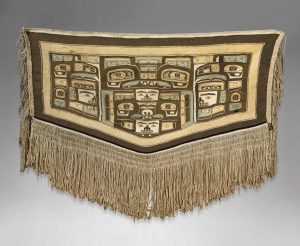
Tlingit chilkat weaving from British Columbia, attributed to Anisalaga (Mary Ebbetts Hunt) 1823-1919
3. Metalwork
Copper and gold were both very common in the Americas before Europeans arrived. The gold is well-known in some ways, since that’s what made the Spanish want to invade so badly. Metallurgy in South America had early developed into a complex artform, complete with smelting technology; gold, silver, electrum, bronze, and tumbaga were all used. Initially metalwork was mostly used for decorative purposes to display status, but by the time of the Inkas had become common for utilitarian purposes as well. By 800 CE smelting technology had spread north to Central America and Mesoamerica, where it was particularly specialized in West Mexico. By the time of the Triple Alliance, the Mixtec peoples were known as the best goldworkers in Mesoamerica.
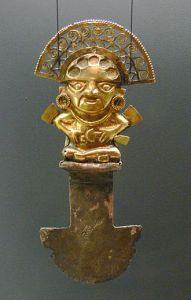
Sican ceremonial knife from Peru
Further north, copper was the metal of choice. It was particularly abundant in the Great Lakes and it was a major part of eastern trade networks even from the earliest times. Copper was initially used for practical use such as knives and fishhooks, but by the time of the Mississippians it had also become popular for decorative depictions of sacred and political images. In addition to its practical usage, it held an important cosmological position for many people in the eastern woodlands, being associated with beings of the upper world such as the Thunderers or of the lower world such as beings called in English “horned serpents” and “underwater panthers.”
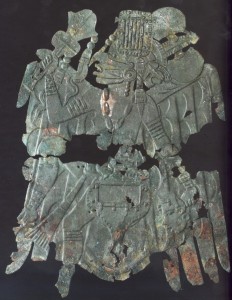
Copper plate from the Etowah site in Georgia
Copper was an important metal in the Pacific Northwest region as well, where much of it seems to have come from sources up in Alaska. Iron from Japanese ships that washed ashore across the Pacific has also been documented both archaeologically and through indigenous oral traditions. There are also suggestions that there may have been trade across the Bering Strait over a long period of time. Early European traders discovered that metals were one of the most highly desired trade goods among the indigenous people there, and worked sheet copper became an important feature of potlatches. Government concern over the “destruction” of valuable copper was in fact a major factor in the banning of potlatches and indigenous ceremonies in the northwest. Traditional designs in metalwork is being revitalized today by many indigenous young people in the region.

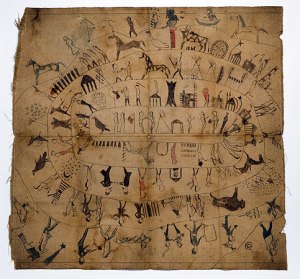
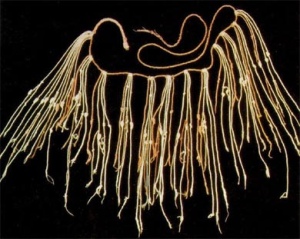
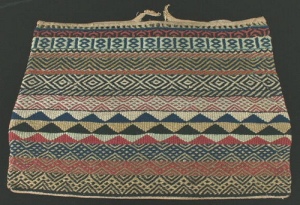
I wonder if the desire to view natives as not having these technologies is rooted in trying to keep them looking “primitive” or “uncivilized” therefore justifying colonial actions against them. Then it just keeps getting passed on through the generations.
I agree with you because the idea of the Native Americans being a highly civilized group of cultures, with cities, tools, weaving, writing, etc did not fit their narrative. I believe this continues on through today. Thousands of artifacts found across the American heartland were destroyed or locked away in museum archives and never studied properly. Even today, anyone who challenges the current theories is branded a heretic by the “professional, educated elite” just as proponents of the solar-centric view of the universe were persecuted for claiming that the earth was not the center of the universe and the round earth believers for claiming that the earth was not flat.
Maybe it has more to do with seeing all Indians as the same. The use of writing, weaving, and metals varied greatly from tribe to tribe in geographical regions as well as what time era we are talking about. I am a docent at an Indian museum and the biggest stereotype has all tribes frozen in a primitive past time. We work hard to dispel that, The best comment I try to leave all visitors with when they ask the question, “What are Indians like?”–
“That depends on where you are talking about and when. Are you talking about Chicago in 2015 or the Plains in the 1700s?” Pretty quick they learn that they haven’t really been taught anything about the native people of this continent, or any other one for that matter. And that just like other human beings, native folks constantly adapt and change.
Reblogged this on moatazyossef.
Reblogged this on stoneylakitu.
I think that this post exemplifies that every indigenous group of people had innovations, and it is good to remember their specific advances.
They also invented the Wheel and Axel. They conceived of the concept in complete isolation independently . The Americans have been to lazy to find out the Native Americans, where barely behind the Europeans when the got here and that was only in guns and gunfire, that they got from the Chinese.
I’m completely white, and the history of your peoples shown on your site is amazing. I think these days white Canadians are not inclined to believe the ‘uncivilized savage’ image that was likely used as a justification for subjugating the indigenous people. I have been completely fascinated with the level of sophistication achieved by the pre-Columbian North American societies in contrast to what “they teach you in school”
Thank you for this post! Our area ( northeast ) had a huge population of Mississippi culture people but the myth is, no one was here. Seems to be based on someone’s academia- a research paper insists our population was migratory so no one will budge. Meanwhile, there are wonderful petroglyphs, effigies, rock carvings, stone tools, cairns and art work. Anyway, we just really, really want to know more of them.
Related to this post, art work carved in stone ( or something, may have been some kind of clay originally? ) show us a LOT of their clothing. Much seems to be composed of long strips, side by side and overlapping? Knowing this was probably fabric, not leather, makes much more sense! Feathers seem to be used, too but around neck line and in hair. Some clothing you just cannot identify although necklaces and hair ornaments are clear. . A professional probably could identify a lot of what is there but we’re just baffled amateurs. Posts like this are very helpful.